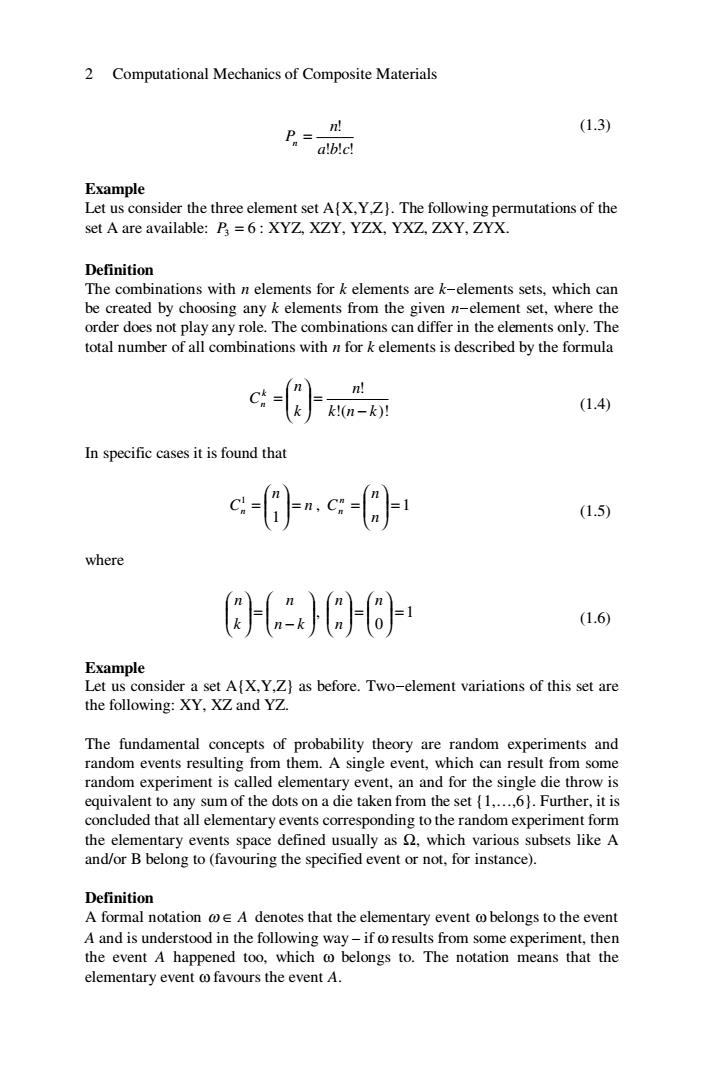正在加载图片...

2 Computational Mechanics of Composite Materials (1.3) alblc! Example Let us consider the three element set A[X,Y,Z).The following permutations of the set A are available:P=6:XYZ,XZY,YZX,YXZ,ZXY,ZYX. Definition The combinations with n elements for k elements are k-elements sets,which can be created by choosing any k elements from the given n-element set,where the order does not play any role.The combinations can differ in the elements only.The total number of all combinations with n for k elements is described by the formula k(n-k)月 (1.4) In specific cases it is found that c0c- (1.5) where G (1.6) Example Let us consider a set AfX,Y,Z)as before.Two-element variations of this set are the following:XY,XZ and YZ. The fundamental concepts of probability theory are random experiments and random events resulting from them.A single event,which can result from some random experiment is called elementary event,an and for the single die throw is equivalent to any sum of the dots on a die taken from the set {1,...,6).Further,it is concluded that all elementary events corresponding to the random experiment form the elementary events space defined usually as which various subsets like A and/or B belong to (favouring the specified event or not,for instance). Definition A formal notation A denotes that the elementary event co belongs to the event A and is understood in the following way-if c results from some experiment,then the event A happened too,which c belongs to.The notation means that the elementary event c favours the event A.2 Computational Mechanics of Composite Materials ! ! ! ! a b c n Pn = (1.3) Example Let us consider the three element set A{X,Y,Z}. The following permutations of the set A are available: 6 P3 = : XYZ, XZY, YZX, YXZ, ZXY, ZYX. Definition The combinations with n elements for k elements are k-elements sets, which can be created by choosing any k elements from the given n-element set, where the order does not play any role. The combinations can differ in the elements only. The total number of all combinations with n for k elements is described by the formula !( )! ! k n k n k n Ck n − =⎟ ⎟ ⎠ ⎞ ⎜ ⎜ ⎝ ⎛ = (1.4) In specific cases it is found that n n Cn =⎟ ⎟ ⎠ ⎞ ⎜ ⎜ ⎝ ⎛ = 1 1 , 1 =⎟ ⎟ ⎠ ⎞ ⎜ ⎜ ⎝ ⎛ = n n Cn n (1.5) where ⎟ ⎟ ⎠ ⎞ ⎜ ⎜ ⎝ ⎛ − =⎟ ⎟ ⎠ ⎞ ⎜ ⎜ ⎝ ⎛ n k n k n , 1 0 =⎟ ⎟ ⎠ ⎞ ⎜ ⎜ ⎝ ⎛ =⎟ ⎟ ⎠ ⎞ ⎜ ⎜ ⎝ ⎛ n n n (1.6) Example Let us consider a set A{X,Y,Z} as before. Two-element variations of this set are the following: XY, XZ and YZ. The fundamental concepts of probability theory are random experiments and random events resulting from them. A single event, which can result from some random experiment is called elementary event, an and for the single die throw is equivalent to any sum of the dots on a die taken from the set {1,…,6}. Further, it is concluded that all elementary events corresponding to the random experiment form the elementary events space defined usually as Ω, which various subsets like A and/or B belong to (favouring the specified event or not, for instance). Definition A formal notation ω ∈ A denotes that the elementary event ω belongs to the event A and is understood in the following way – if ω results from some experiment, then the event A happened too, which ω belongs to. The notation means that the elementary event ω favours the event A